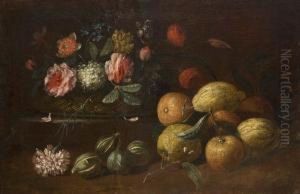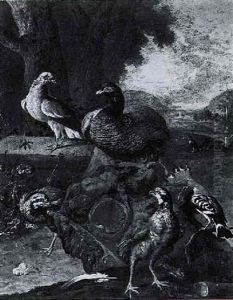Willem Van Royen Paintings
Willem van Royen, also known as Guilliam van Royen or Willem van Roijen, was a Dutch Golden Age painter known for his detailed still life paintings, particularly of fruits and flowers. Although not as widely recognized as some of his contemporaries, van Royen's work exemplifies the skill and attention to detail characteristic of 17th-century Dutch still life painters.
Born in Haarlem in 1645, Willem van Royen was part of an era where Dutch art flourished, with a particular emphasis on realistic depictions of everyday objects. At this time, the Dutch Republic was experiencing what is now known as the Dutch Golden Age, marked by great wealth, cultural achievements, and a strong appreciation for the visual arts. Still life painting was a popular genre, often imbued with symbolic meanings related to the transience of life and the abundance provided by the booming Dutch trade economy.
Van Royen is noted for his delicate handling of light and texture, which brought his arrangements of fruits, flowers, and sometimes birds, to life. His compositions often contained peaches, grapes, and pears, rendered with a soft, tactile quality that invited viewers to reach out and touch them. However, unlike some of his contemporaries who included moralizing or vanitas elements in their work, van Royen's paintings were typically void of such symbolism and focused more on the beauty and realism of the subject matter.
Details of van Royen's training are scarce, but it is believed he was influenced by the Haarlem school of painting, which included artists like Pieter Claesz and Willem Claesz Heda, known for their monochromatic banketje (banquet) still lifes. Van Royen's work often shared the detailed execution and compositional choices seen in the works of these artists.
Van Royen's death in 1723 marked the end of a long career during a vibrant period in Dutch art. While he may not have achieved the same level of fame as some of his peers, his paintings continue to be appreciated for their craftsmanship and the glimpse they offer into the aesthetic values of his time. Today, Willem van Royen's works can be found in various art museums and private collections, contributing to the rich tapestry of Dutch Golden Age painting.






